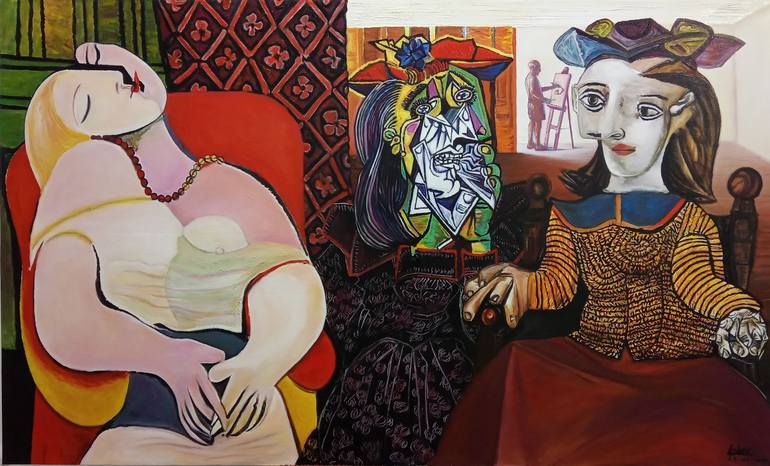







241 Views
13
View In My Room
Painting, Oil on Canvas
Size: 66.9 W x 40.6 H x 1.2 D in
Ships in a Tube
$1,115
Shipping included
14-day satisfaction guarantee
Trustpilot Score
241 Views
13
Artist Recognition

Artist featured in a collection
ABOUT THE ARTWORK
DETAILS AND DIMENSIONS
SHIPPING AND RETURNS
Author: William Marquina Title: Picasso’s Chats Technique: oil on canvas Dimensions: 103 x 170 cm (40.55 x 66.92 in) Year: 2020 Key words: Pablo Picasso, Picasso, cubism, Dora Maar, Marie Therése-Walter, portrait, 20th century, Yellow Jersey, Woman Crying, the dream. networks. Description: ...
Year Created:
2020
Subject:
Styles:
Mediums:
Painting, Oil on Canvas
Rarity:
One-of-a-kind Artwork
Size:
66.9 W x 40.6 H x 1.2 D in
Ready to Hang:
Not Applicable
Frame:
Not Framed
Authenticity:
Certificate is Included
Packaging:
Ships Rolled in a Tube
Delivery Cost:
Shipping is included in price.
Delivery Time:
Typically 5-7 business days for domestic shipments, 10-14 business days for international shipments.
Returns:
14-day return policy. Visit our help section for more information.
Handling:
Ships rolled in a tube. Artists are responsible for packaging and adhering to Saatchi Art’s packaging guidelines.
Ships From:
Ecuador.
Need more information?
Need more information?
William Marquina was born in Merida, Venezuela. Attracted by the works of great masters such as Picasso and Leonardo, at the age of 11 he participated in a Sunday outdoor painting workshop. After graduating in visual arts at the University of Los Andes, he studied for a master’s degree in philosophy, followed by an unfinished doctorate, and was a short-term visual arts teacher at the same university. From now on, William will pursue his passion for art by experimenting with different themes, techniques, styles and media. Disappointed by the unstable situation in his country, he emigrated to the city of Quito in 2019 where he currently lives and produces his works. William’s production has been experimentally versatile and challenges us with series characterized by the desire to seek, study and complement the archaic and the contemporary. Among his series are: Brillo, Copia Picasso, Copia Matisse, Copia Da Vinci and Apercepciones. In the latter, he highlights in painting, the subjective complexity in the world of perceptions. He has been exhibiting his recent works in the city of Quito: “What do you see?” at the Humboldt Association (2024); a collective exhibition at the AQ Arte Feria de Quito (2024). In 2023 his retrospective “Imbrications in Painting”; in 2021 International Painting Exhibition at the Casal Català Quito and in 2019 “Exhibition of Ecuadorian Painting” at the Quito City Hall. Other important individual exhibitions but in Venezuela were: in 2012 “Cartographies of the Terrestrial and the Transterráneo”; in 2017 “Care. Path and Limit”, and in 2007 “Essences”. Awarded the First Prize for Arts for University Students, in 2001.
Artist Recognition

Artist featured by Saatchi Art in a collection
Why Saatchi Art?
Thousands of
5-Star Reviews
We deliver world-class customer service to all of our art buyers.
Global Selection of Original Art
Explore an unparalleled artwork selection from around the world.
Satisfaction Guaranteed
Our 14-day satisfaction guarantee allows you to buy with confidence.
Support Emerging Artists
We pay our artists more on every sale than other galleries.
